Wind and Weird Ocean Weather Phenomena
Special Stories
25 Oct 2018 8:19 AM
[Iceberg in the Arctic with its underside exposed. From Wikimedia Commons]
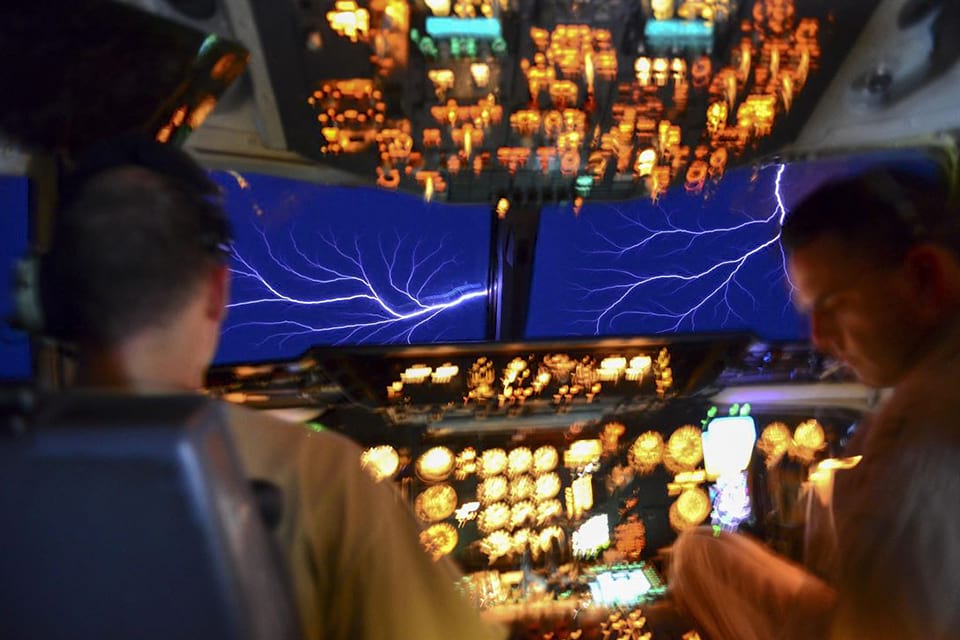 St. Elmo's Fire is a colorful discharge of atmospheric electricity that typically occurs during a thunderstorm. When a sharp object (such as a ship’s mast) comes in contact with an extraordinarily high electrical field and a large number of electrons, the electrons can glow in various colors, like a neon sign, resulting in this rare phenomenon. “St. Elmo” is a derivation of St. Erasmus of Formia, one of the two patron saints of sailors.
St. Elmo's Fire is a colorful discharge of atmospheric electricity that typically occurs during a thunderstorm. When a sharp object (such as a ship’s mast) comes in contact with an extraordinarily high electrical field and a large number of electrons, the electrons can glow in various colors, like a neon sign, resulting in this rare phenomenon. “St. Elmo” is a derivation of St. Erasmus of Formia, one of the two patron saints of sailors.
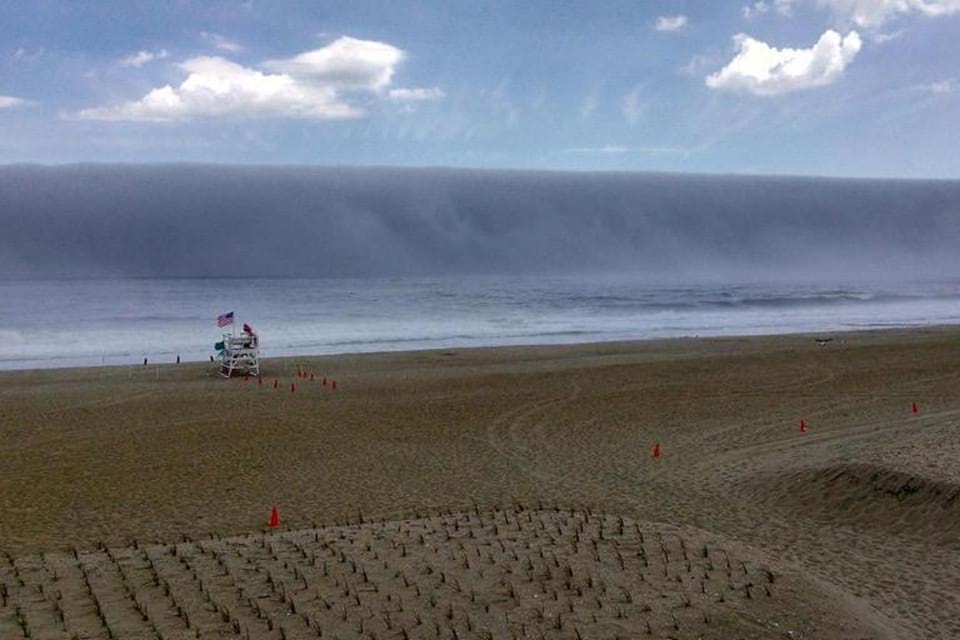 At first glance, this jarring sight looks like a giant tsunami rolling in from the ocean, but it’s actually a massive amount of fog. When conditions are just right in late spring or early summer, the condensation from warm air merging with cool ocean water can create this dramatic effect.
At first glance, this jarring sight looks like a giant tsunami rolling in from the ocean, but it’s actually a massive amount of fog. When conditions are just right in late spring or early summer, the condensation from warm air merging with cool ocean water can create this dramatic effect.
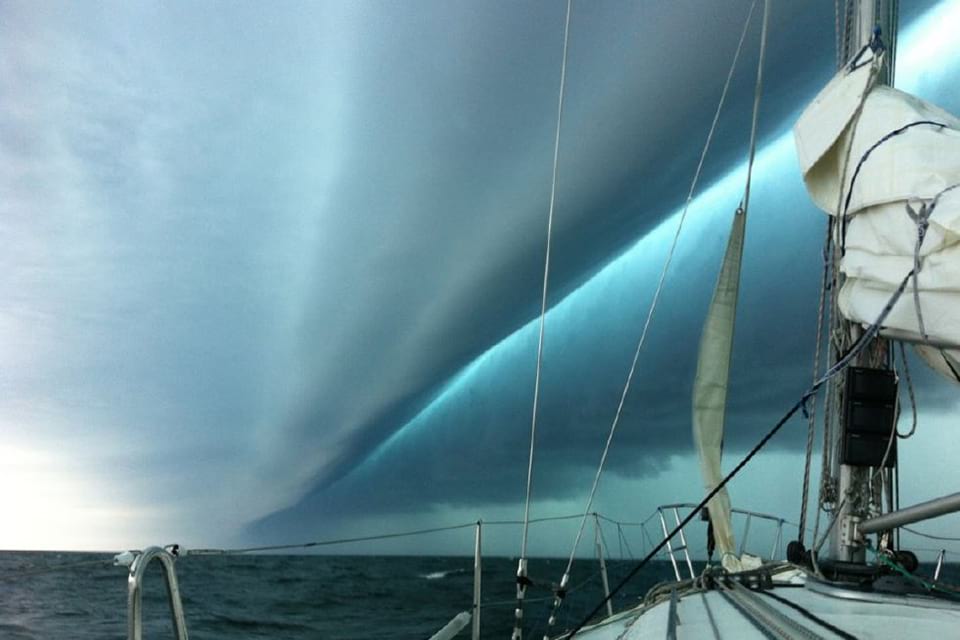 Meteotsunamis have characteristics similar to earthquake-generated tsunamis, but they are caused by air-pressure disturbances often associated with fast-moving weather systems, such as squall lines. These disturbances can generate waves in the ocean that travel at the same speed as the overhead weather system. Development of a meteotsunami depends on several factors, such as the intensity, direction, and speed of the air pressure as it travels over a waterbody. Like an earthquake-generated tsunami, a meteotsunami affects the entire water column and may become dangerous when it hits shallow water, which causes it to slow down and increase in height and intensity. Semi-enclosed water bodies like harbors, inlets, and bays can greatly intensify a meteotsunami.
Meteotsunamis have characteristics similar to earthquake-generated tsunamis, but they are caused by air-pressure disturbances often associated with fast-moving weather systems, such as squall lines. These disturbances can generate waves in the ocean that travel at the same speed as the overhead weather system. Development of a meteotsunami depends on several factors, such as the intensity, direction, and speed of the air pressure as it travels over a waterbody. Like an earthquake-generated tsunami, a meteotsunami affects the entire water column and may become dangerous when it hits shallow water, which causes it to slow down and increase in height and intensity. Semi-enclosed water bodies like harbors, inlets, and bays can greatly intensify a meteotsunami.
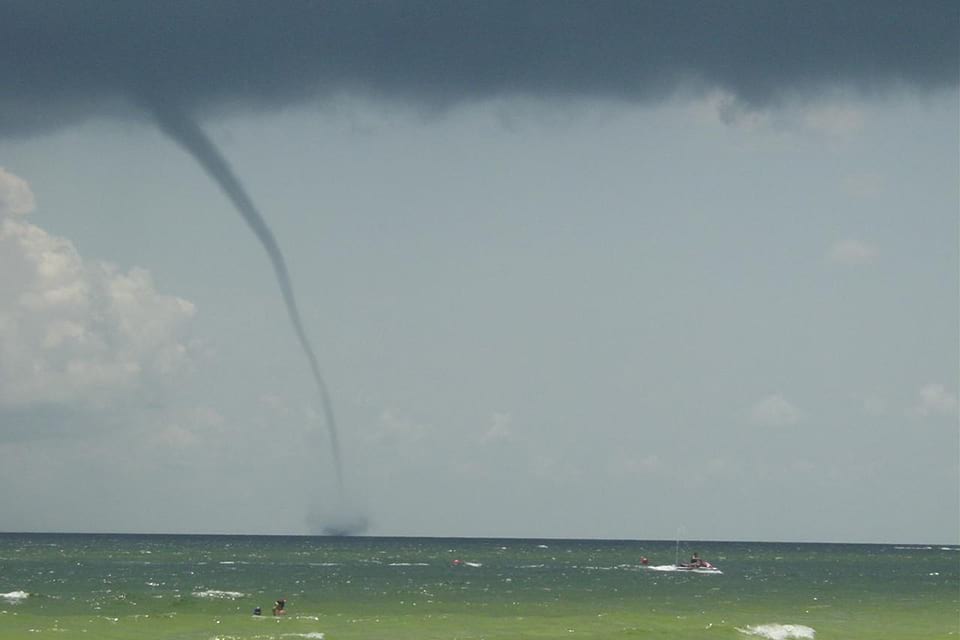 A waterspout is a spinning column of air and mist that forms on lakes, rivers, and at sea. Waterspouts fall into two categories: fair weather and tornadic. Tornadic waterspouts are tornadoes that form over water, or move from land to water. They are associated with severe thunderstorms and are often accompanied by high winds and seas, large hail, and dangerous lightning. The tornadic variety are more dangerous than fair weather waterspouts, which generally are not associated with thunderstorms, and usually form along the dark flat base of a line of developing cumulus clouds. While tornadic waterspouts develop downward in a thunderstorm, a fair weather waterspout develops on the surface of the water and works its way upward. Fair weather waterspouts form in light wind conditions so they normally move very little.
A waterspout is a spinning column of air and mist that forms on lakes, rivers, and at sea. Waterspouts fall into two categories: fair weather and tornadic. Tornadic waterspouts are tornadoes that form over water, or move from land to water. They are associated with severe thunderstorms and are often accompanied by high winds and seas, large hail, and dangerous lightning. The tornadic variety are more dangerous than fair weather waterspouts, which generally are not associated with thunderstorms, and usually form along the dark flat base of a line of developing cumulus clouds. While tornadic waterspouts develop downward in a thunderstorm, a fair weather waterspout develops on the surface of the water and works its way upward. Fair weather waterspouts form in light wind conditions so they normally move very little.
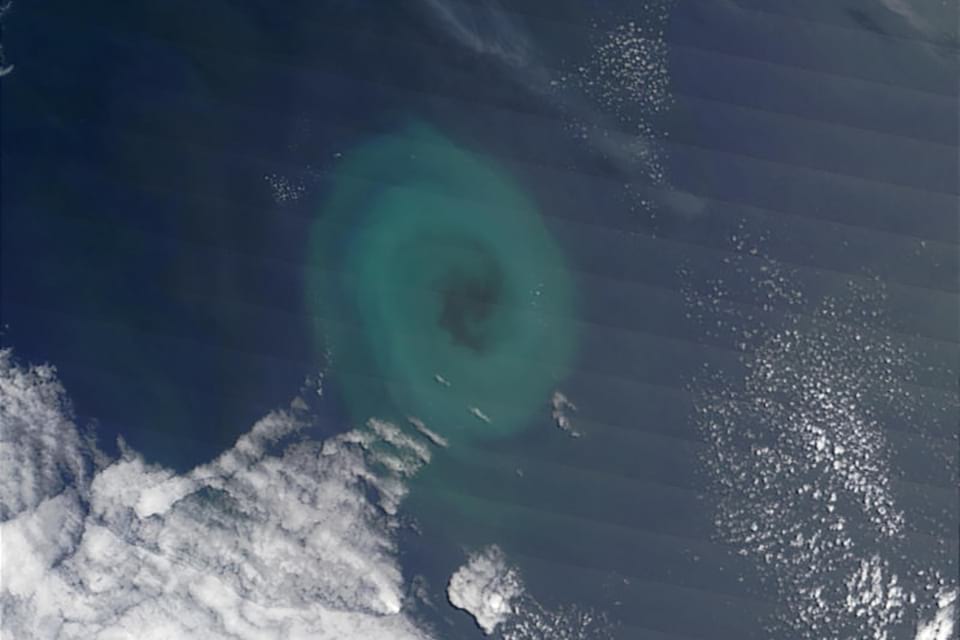 A maelstrom is a strong whirlpool that forms when opposing currents meet to form swirling water. Its name comes from the Dutch words malen (to whirl or grind) and strom (stream). A maelstrom can be dangerous due to powerful currents that occur below the surface, which can pull surrounding objects into its vortex.
A maelstrom is a strong whirlpool that forms when opposing currents meet to form swirling water. Its name comes from the Dutch words malen (to whirl or grind) and strom (stream). A maelstrom can be dangerous due to powerful currents that occur below the surface, which can pull surrounding objects into its vortex.
[NOAA] The ocean may conjure images of beautiful waves, shipwrecks, and marine life. But strange things happen in the ocean as a result of weather and currents. The five events described below are just a few of them.
1. St. Elmo's Fire
 St. Elmo's Fire is a colorful discharge of atmospheric electricity that typically occurs during a thunderstorm. When a sharp object (such as a ship’s mast) comes in contact with an extraordinarily high electrical field and a large number of electrons, the electrons can glow in various colors, like a neon sign, resulting in this rare phenomenon. “St. Elmo” is a derivation of St. Erasmus of Formia, one of the two patron saints of sailors.
St. Elmo's Fire is a colorful discharge of atmospheric electricity that typically occurs during a thunderstorm. When a sharp object (such as a ship’s mast) comes in contact with an extraordinarily high electrical field and a large number of electrons, the electrons can glow in various colors, like a neon sign, resulting in this rare phenomenon. “St. Elmo” is a derivation of St. Erasmus of Formia, one of the two patron saints of sailors.
2. Fog “Tsunami”
 At first glance, this jarring sight looks like a giant tsunami rolling in from the ocean, but it’s actually a massive amount of fog. When conditions are just right in late spring or early summer, the condensation from warm air merging with cool ocean water can create this dramatic effect.
At first glance, this jarring sight looks like a giant tsunami rolling in from the ocean, but it’s actually a massive amount of fog. When conditions are just right in late spring or early summer, the condensation from warm air merging with cool ocean water can create this dramatic effect.
3. Meteotsunami
 Meteotsunamis have characteristics similar to earthquake-generated tsunamis, but they are caused by air-pressure disturbances often associated with fast-moving weather systems, such as squall lines. These disturbances can generate waves in the ocean that travel at the same speed as the overhead weather system. Development of a meteotsunami depends on several factors, such as the intensity, direction, and speed of the air pressure as it travels over a waterbody. Like an earthquake-generated tsunami, a meteotsunami affects the entire water column and may become dangerous when it hits shallow water, which causes it to slow down and increase in height and intensity. Semi-enclosed water bodies like harbors, inlets, and bays can greatly intensify a meteotsunami.
Meteotsunamis have characteristics similar to earthquake-generated tsunamis, but they are caused by air-pressure disturbances often associated with fast-moving weather systems, such as squall lines. These disturbances can generate waves in the ocean that travel at the same speed as the overhead weather system. Development of a meteotsunami depends on several factors, such as the intensity, direction, and speed of the air pressure as it travels over a waterbody. Like an earthquake-generated tsunami, a meteotsunami affects the entire water column and may become dangerous when it hits shallow water, which causes it to slow down and increase in height and intensity. Semi-enclosed water bodies like harbors, inlets, and bays can greatly intensify a meteotsunami.
4. Waterspout
 A waterspout is a spinning column of air and mist that forms on lakes, rivers, and at sea. Waterspouts fall into two categories: fair weather and tornadic. Tornadic waterspouts are tornadoes that form over water, or move from land to water. They are associated with severe thunderstorms and are often accompanied by high winds and seas, large hail, and dangerous lightning. The tornadic variety are more dangerous than fair weather waterspouts, which generally are not associated with thunderstorms, and usually form along the dark flat base of a line of developing cumulus clouds. While tornadic waterspouts develop downward in a thunderstorm, a fair weather waterspout develops on the surface of the water and works its way upward. Fair weather waterspouts form in light wind conditions so they normally move very little.
A waterspout is a spinning column of air and mist that forms on lakes, rivers, and at sea. Waterspouts fall into two categories: fair weather and tornadic. Tornadic waterspouts are tornadoes that form over water, or move from land to water. They are associated with severe thunderstorms and are often accompanied by high winds and seas, large hail, and dangerous lightning. The tornadic variety are more dangerous than fair weather waterspouts, which generally are not associated with thunderstorms, and usually form along the dark flat base of a line of developing cumulus clouds. While tornadic waterspouts develop downward in a thunderstorm, a fair weather waterspout develops on the surface of the water and works its way upward. Fair weather waterspouts form in light wind conditions so they normally move very little.
5. Maelstrom
 A maelstrom is a strong whirlpool that forms when opposing currents meet to form swirling water. Its name comes from the Dutch words malen (to whirl or grind) and strom (stream). A maelstrom can be dangerous due to powerful currents that occur below the surface, which can pull surrounding objects into its vortex.
A maelstrom is a strong whirlpool that forms when opposing currents meet to form swirling water. Its name comes from the Dutch words malen (to whirl or grind) and strom (stream). A maelstrom can be dangerous due to powerful currents that occur below the surface, which can pull surrounding objects into its vortex.
All Weather News
More